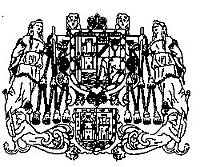Antonio Ibáñez de la Riva Herrera facts for kids
Quick facts for kids Most Reverend Antonio Ibáñez de la Riva Herrera |
|
|---|---|
| Archbishop of Zaragoza | |
| Church | Catholic Church |
| In Office | 1687–1710 |
| Predecessor | Diego de Castrillo |
| Successor | Manuel Pérez Araciel y Rada |
| Orders | |
| Consecration | 8 Jul 1685 by Alfonso Enríquez de Santo Tomás |
| Personal details | |
| Born | 1635 |
| Died | 3 Sep 1710 (age 75) |
Antonio Ibáñez de la Riva Herrera (1635–1710) was a Spanish bishop. He was also the Grand Inquisitor of Spain for a short time, from 1709 to 1710.
Contents
Biography of a Spanish Leader

Antonio Ibáñez de la Riva Herrera was born in a place called Solares in Cantabria, Spain. He went to the University of Salamanca to study. After his studies, he became a priest.
He then became a canon, which is a type of priest who works at a cathedral. He worked at the Colegio Mayor de San Ildefonso and later at Málaga Cathedral.
Becoming a Bishop and Archbishop
In 1685, Antonio Ibáñez became the Bishop of Ceuta. On July 8, 1685, he was officially made a bishop by Alfonso Enríquez de Santo Tomás, who was the Bishop of Málaga.
In 1687, he moved to a new role. He became the Archbishop of Zaragoza, a very important position.
Important Roles in Government
Antonio Ibáñez also held high positions in the Spanish government. In 1690, Charles II of Spain made him the President of the Council of Castile. This was a powerful group that advised the king. He held this job until 1692.
From 1693 to 1696, he served as Viceroy and Captain General of the Kingdom of Aragon. A viceroy was like a governor who ruled a region for the king.
In 1697, he held a synod in Zaragoza. A synod is a meeting of church leaders to discuss important matters.
War and Leadership
When the War of the Spanish Succession started in 1701, he again became Viceroy and Captain General of Aragon. During this war, Aragon stayed loyal to Philip V of Spain because of Antonio Ibáñez's leadership.
From 1709 to 1710, he was the Grand Inquisitor of Spain. This meant he was the head of the Spanish Inquisition, a powerful church court.
Later Life and Legacy
Antonio Ibáñez de la Riva Herrera passed away in Madrid in 1710. Many years later, in 1780, his body was moved to La Seo Cathedral in Zaragoza.
See also
 In Spanish: Antonio Ibáñez de la Riva Herrera para niños
In Spanish: Antonio Ibáñez de la Riva Herrera para niños


